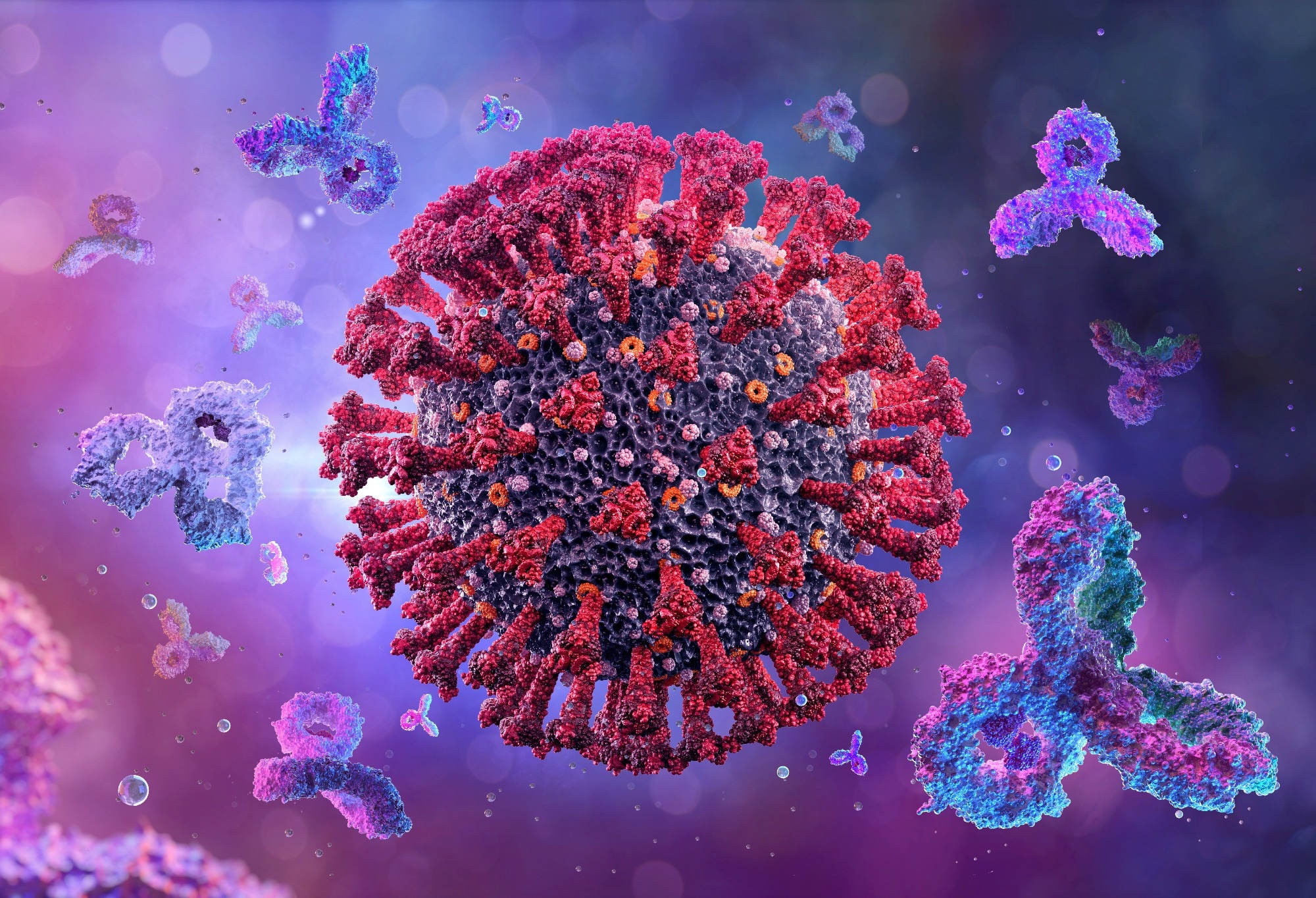In a recent study posted to the bioRxiv* preprint server, researchers described four novel monoclonal antibodies with potent and broad neutralization activity against severe acute respiratory syndrome coronavirus 2 (SARS-CoV-2) variants, including the current globally dominant Omicron BA.4/BA.5.
 Study: Identification of broad, potent antibodies to functionally constrained regions of SARS-CoV-2 spike following a breakthrough infection. Image Credit: Corona Borealis Studio/Shutterstock
Study: Identification of broad, potent antibodies to functionally constrained regions of SARS-CoV-2 spike following a breakthrough infection. Image Credit: Corona Borealis Studio/ShutterstockBackground
Although the early impetus to develop coronavirus disease 2019 (COVID-19) vaccines and the use of monoclonal antibody therapies successfully limited the severity of SARS-CoV-2 infections, the emergence of Omicron subvariants with mutations in the spike protein receptor binding domain (RBD) is challenging the vaccine-induced immunity.
Since early vaccines and monoclonal antibodies targeted the receptor binding motif that binds to the angiotensin-converting enzyme-2 (ACE-2) receptor, these novel mutations allow the emergent Omicron subvariants to escape the neutralizing antibodies generated against the RBD of earlier variants, reducing the efficacy of the therapeutic monoclonal antibodies in clinical use.
Combining monoclonal antibodies that target a wide variety of epitopes, including conserved regions inside and outside the RBD, might not only broaden the therapeutic antibodies' neutralizing activity but also help reduce the selection pressure driving the development of new variants of concern.
About the study
In the present study, the researchers isolated monoclonal antibodies specific for SARS-CoV-2 spike proteins from a patient who experienced a Delta variant breakthrough infection two months after completing the primary vaccination regimen with the Pfizer-BioNTech messenger ribonucleic acid (mRNA) vaccine. Peripheral blood mononuclear cells (PBMCs) were collected after 30 days of the onset of symptoms to isolate memory B cells using spike-subunit 2 or Delta spike protein peptide baits. Variable regions of the heavy and light chain immunoglobulin genes were recovered and cloned into immunoglobulin G (IgG) kappa, lambda, or gamma constructs to produce monoclonal antibodies.
Enzyme-linked immunosorbent assays (ELISA) were used to screen these monoclonal antibodies using a panel of SARS-CoV-2 spike glycoproteins from multiple variants. Biolayer interferometry (BLI) was performed to assess the binding affinity of the identified monoclonal antibodies to spike proteins from Omicron subvariants BA.1, BA.2, and BA.4/BA.5, as well as from the ancestral Wuhan-Hu-1 and SARS-CoV-1 spike glycoproteins.
Neutralization assays using spike-pseudotyped lentivirus and live SARS-CoV-2 were conducted to test the neutralizing potency of the monoclonal antibodies. The neutralizing activity of the selected monoclonal antibodies was also compared to that of monoclonal antibodies authorized for treating SARS-CoV-2 infections. The neutralization assay with pseudotyped lentivirus also assessed the neutralizing capacity of the plasma samples collected from the participant.
The live virus neutralization assay tested the efficacy of the monoclonal antibodies against a wide range of variants, including the ancestral Wuhan-Hu-1 strain and the Alpha and Delta variants. The Omicron subvariants BA.1, BA.2, and BA.2.12.1.
Additionally, various recombinant spike subdomain peptides were used to identify the spike glycoprotein regions to which the monoclonal antibodies were binding. Commercial monoclonal antibodies belonging to RBD classes based on the structural analysis of contact residues and epitope accessibility and deep mutational scanning were employed for competition ELISA to refine the epitopes of the selected monoclonal antibodies.
Fluorescence-activated cell sorting-based assay and yeast display libraries of mutated RBDs were used to determine the effect of a single amino acid substitution mutation on the binding of the monoclonal antibody to the epitope. Structural methods such as cryogenic electron microscopy (cryo-EM) structure determination and hydrogen-deuterium exchange mass spectrometry were also conducted to examine the epitopes targeted by selected monoclonal antibodies.
Results
The results described four monoclonal antibodies isolated from a patient with a heterologous antigen exposure to the spike proteins from the ancestral Wuhan-Hu-1 strain through vaccination and the Delta variant spike protein from breakthrough infections. In the neutralization assays using pseudotyped lentiviruses and live SARS-CoV-2 viruses, these four antibodies displayed neutralizing activity against the currently dominant Omicron subvariants BA.4/BA.5 while retaining potent neutralizing capacity against the Wuhan-Hu-1 strain and the Delta variant. One of the monoclonal antibodies was also able to neutralize SARS-CoV-1.
Compared to the monoclonal antibodies currently in clinical use, the potency of the newly isolated monoclonal antibodies against the Omicron subvariants was higher than all the currently approved therapeutic monoclonal antibodies except one. The epitopes targeted by these monoclonal antibodies included one in subdomain 1 in an invariant region outside the RBD and three in the RBD. The deep mutational scanning analysis to identify escape pathways from single amino acid substitutions showed that these monoclonal antibodies targeted conserved and constrained regions of the spike glycoprotein. These findings suggested that viruses could evolve to escape these monoclonal antibodies only at a fitness cost.
Conclusions
To summarize, the study identified four novel monoclonal antibodies that exhibited broad neutralization of a range of SARS-CoV-2 variants, including the Omicron subvariants BA.4/BA.5 and the ancestral Wuhan-Hu-1 strain and the Delta variant. These monoclonal antibodies target three epitopes in the RBD and one in subdomain 1 outside the RBD. Since these epitopes are highly conserved, the evolution of the virus to escape neutralization by these monoclonal antibodies could be detrimental to its fitness.
*Important notice
bioRxiv publishes preliminary scientific reports that are not peer-reviewed and, therefore, should not be regarded as conclusive, guide clinical practice/health-related behavior, or treated as established information.
- Jamie Guenthoer, Michelle Lilly, Tyler N Starr, Bernadeta Dadonaite, Klaus N Lovendahl, Jacob T Croft, Caitlin I Stoddard, Vrasha Chohan, Shilei Ding, Felicitas Ruiz, Mackenzie S Kopp, Andrés Finzi, Jesse D Bloom, Helen Y Chu, Kelly K Lee, and Julie Overbaugh. (2022). Identification of broad, potent antibodies to functionally constrained regions of SARS-CoV-2 spike following a breakthrough infection. bioRxiv. doi: https://doi.org/10.1101/2022.12.15.520606 https://www.biorxiv.org/content/10.1101/2022.12.15.520606v1
Study identifies four new monoclonal antibodies with broad neutralizing potencies that target conserved SARS-CoV-2 epitopes - News-Medical.Net
Read More

No comments:
Post a Comment